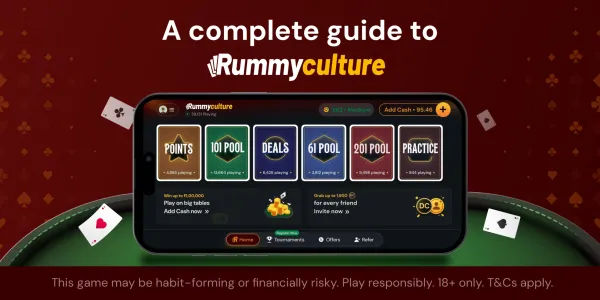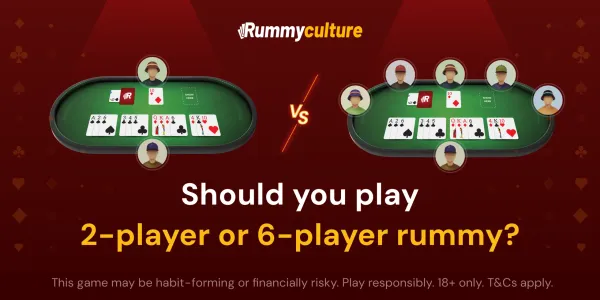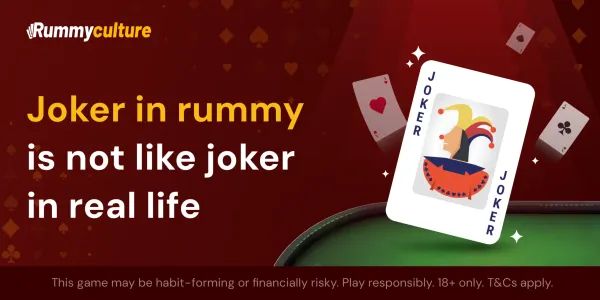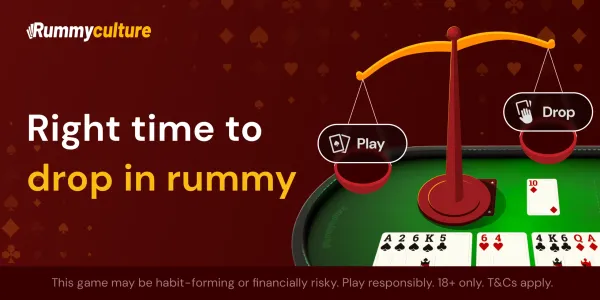Rummy rules - learn how to play rummy game
Rummy is a card game that you play with two standard decks of cards and two printed Joker cards, between 2-6 players. One of them is called the closed deck, where the cards are placed face down and the player cannot see the cards they are picking. To understand rummy rules, it is important to know how to form valid sequences and sets. To win a game of rummy, a player must make a valid declaration that has to compulsorily have 1 pure sequence and 1 other sequence, while the rest of the cards can be grouped into either sets or sequences. Mastering these rummy game rules ensures a strategic advantage in every rummy card game.
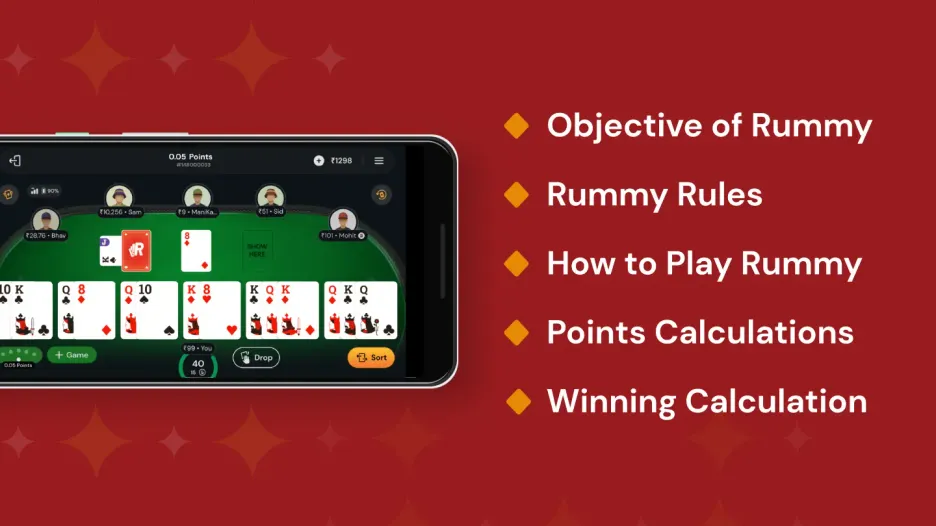
Rummy Rules and Objectives of the Game
Table of contents
Primary objective of the Indian rummy game
In an Indian rummy card game, which is widely played with 13 cards, players need to arrange all their cards into sets or sequences and make a valid declaration to win the game. This rummy game can be played among 2 to 6 players, using 1-2 standard decks of 52 cards. According to the rummy rules, players must have two sequences and at least one pure sequence to make a valid declaration. If a player declares without forming a pure sequence, the declaration is considered invalid as per the rummy game rules. These rummy card game rules ensure fair play and add structure to the gameplay.
How to form sequences in a rummy game
A sequence is a group of three or more consecutive cards of the same suit. In rummy rules, there are two types of sequences: pure sequences and impure sequences. To win the game, you need at least one pure sequence in your hand, and at least 2 sequences in total.
Pure Sequence vs Impure Sequence
| Aspect | Pure Sequence | Impure Sequence |
|---|---|---|
| Definition | A sequence of 3 or more consecutive cards of the same suit without any Joker card. | A sequence formed using a Joker (wild card or printed) to replace the missing card(s). |
| Requirement | At least 1 pure sequence is compulsory to win. | Not compulsory but helps complete a set. |
| Examples | Example 1: 3❤️, 4❤️, 5❤️ Example 2: A♣️, K♣️, Q♣️, J♣️ Example 3: 7♦️, 8♦️, 9♦️, 10♦️, J♦️ |
Example 1: 10♦️, 3♣, Q♦️, K♦️ Example 2: 9♠️, Joker, J♠️ Example 3: 8♦️, 2❤️, J♦️, Joker |
| Rules for Ace | Ace can be used as the highest card (A♦️, K♦️, Q♦️) or the lowest card (A♠️, 2♠️, 3♠️) but cannot be in the middle (e.g., 2♣️, A♣️, K♣️). | No specific rules for the Ace; it depends on how the Joker is used to complete the sequence. |
| Joker usage | Jokers are NOT allowed. | Jokers (wild card or printed) are allowed and can be used to replace one or more missing cards. |
| Additional notes | A pure sequence can consist of any number of cards but is still considered a single sequence. | Multiple Jokers can be used to form an impure sequence. On some platforms, a maximum of 2 Jokers is allowed, but on apps like RummyCulture, any number of Jokers can be used. |
| Key difference | Cards must be consecutive and from the same suit without Jokers. But, a wildcard joker can be used if it fits naturally into a pure sequence | Allows the use of Jokers to replace missing cards to complete the sequence. |
Here are 2 life rules for need to remember while farming sequence in rummy
First life rule
In a game of Indian rummy, forming a pure sequence is said to be the first life of the game, because you can’t make any valid sequences or sets without making a pure sequence first.
Second life rule
After getting the first life by forming a pure sequence, a player gets a second life when they make another sequence, which could be pure or impure. To be able to make a valid declaration, a player must have both the first and the second lives.
How to form sets in a rummy game
When a player groups 3 or 4 cards of the same rank and different suits, the grouping is called a set. A set of 3 cards is also called a triplet, and a set of 4 cards is called a quadruplet. According to the rummy rules, A Joker card can be used to form a valid set. Remember, a set can only have a maximum of 4 cards without using any Joker card(s), as there are only 4 different suits and no suit can be repeated in a set. However, as per the rummy game rules, a set of more than 4 cards can also be formed using Joker card(s). Also, note that making sets is not mandatory to win a rummy game.
Examples of valid sets:
This is an example of a valid triplet.
This is an example of a valid quadruplet.
In the above scenario, K♦ is a wild card Joker and can be used to replace A ♥️ or A ♦️.
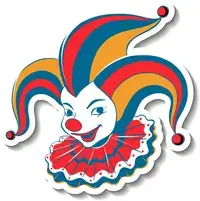
Here, 2 Joker cards have been used to make a quadruplet.


Here, 2 printed Joker cards and K♦ which is a wild card Joker, have been used to make a 5-card set.
✅ You can do:

❌ You can’t do:

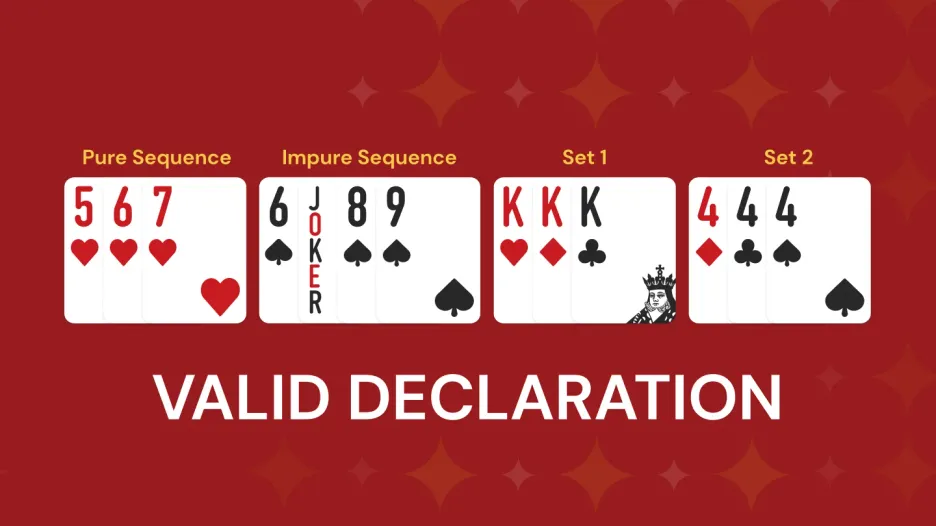
Formation of sequences and sets in 13-card rummy
How to play rummy
In a nutshell, to win a rummy card game, one has to group their 13 cards into various sequences and sets and be the first one to declare with valid groupings (or melds). Once 13 cards are arranged into groupings, the last card is placed on the table face down to make a declaration. According to the rummy game rules, the grouping must include at least one pure sequence to ensure the declaration is valid. In the following sections, you will learn more about how to play rummy, rummy rules, and the common terms used in it.
Rummy rules and objectives of the game
- Before the game begins, a toss is held to determine who goes first. Each player is dealt a single card. Whoever has the highest-ranking card will begin the game.
- Once the turn order is decided, 13 cards are dealt to each player from a well-shuffled deck or decks of cards. After dealing the cards to players, the remaining cards are placed face down on the table, forming the closed deck. Another card deck called the open deck is created by placing the top card of the closed deck face up. This deck is where the players discard their cards.
- The player winning the toss begins. The game then proceeds in the clockwise direction in the case of a 6-player game.
- Each player has the option to pick a card from the closed deck or open deck on every turn. Once a card is picked up, the player has to discard a card, which goes face-up to the open deck.
- In a rummy game, there are two types of Joker cards: printed and wild card. Joker cards are used to fill in for missing cards when making sequences and/or sets.
- When all 13 cards in hand are arranged in sequences and/or sets, the player discards the last unwanted card to make a valid declaration in the game.
- Each card carries a point value in the game. At the end of a game, points are calculated for the ungrouped cards. Every card from 2 to 10 is worth its face value, and all face cards, i.e., J, Q, K, and aces, carry 10 points each. Joker cards are worth 0 points.
Common terms in rummy rules
Every rummy player should be well-versed with terminologies used in the game. Doing so can help them learn the game faster. Listed below are the commonly used terms for rummy rules.
Gametable and Lobby
In online rummy, a game table is a virtual space where a maximum of 6 players can join and play a game of rummy. The lobby is the place where you can find different games and tournaments with various formats and values.
Decks
There are two decks on a game table: a closed deck and an open deck. The closed deck is made of all the cards left over after distributing 13 cards to each player. It is kept face-down on the table. The top card from this deck is then put at the center of the table as the open card, and this card starts what is called the open deck. The open deck is where players leave their extra card on each turn. Each player can choose to pick a card from either of the decks during their turn, but the card they get rid of will only go to the open deck. As an exception, players cannot pick up a discarded Joker card from the open deck, unless it’s the first open card.
Draw and Discard
The act of picking a card from either of the decks is called drawing. Discarding is the act of disposing of the extra card at the end of one’s turn.
Melds
A group of cards that makes a sequence or a set is called a meld. A player must make melds out of all 13 cards in hand to make a valid declaration.
Card Sorting
When you play on a rummy app, players have the option to sort their cards. This feature separates all cards according to suits and in ascending order (from the lowest to the highest ranked cards available in a suit), helping players make quick decisions and play the game more efficiently.
Invalid Declaration
There can be three types of invalid declarations. The first is when a player does not have any pure sequence. The second occurs when a player forms an incorrect sequence or misses making it completely, and in the third scenario, an invalid declaration happens when a set is formed incorrectly.
Declaration with an invalid sequence
Example 1: No pure sequence
Let us consider the following example. Can you spot what’s missing here?

In this hand, the player is missing a 3♦ which would complete the first meld (A♦ 2♦ 4♦ 5♦). Without it, this is not a pure sequence, which makes the declaration invalid.
Example 2: No second sequence/invalid sequence
Let us consider the same hand with slightly different cards. Now, we can see that the pure sequence is there, then why is it not a valid declaration?

In this hand, Q♠️ 9♠️ Joker🃏make an invalid sequence. There needs to be another card (either J♠ or 10♠) along with the printed Joker to form the sequence. Without the second sequence, the declaration becomes invalid.
In this example, we can see that there is only 1 pure sequence but no second sequence at all. Thus, this declaration would be invalid.
Example 3: Invalid sets
Look at the hand below. Can you spot the error?

The last set of 8s is invalid as it has two 8♥. A valid set has cards from different suits and no suit must be repeated.
Rummy rules for joker cards
What is a joker?
Joker cards are used to substitute other cards in sequences and sets. In a rummy game, the Joker cards are worth zero points, but their proper usage with high-value cards can act as a catalyst for winning a rummy game. There are two types of Joker cards in a rummy game:
Printed Joker:
Each standard deck of cards comes with 1 printed Joker card. When playing rummy, sometimes more than one standard deck of cards is used, so there are 2 or more printed Joker cards. Each Joker card is worth zero points.
Wild card Joker:
Wild card Joker is a card that is selected randomly in the beginning of a game. Once this card is picked, all cards of the same rank will be treated as Joker cards.
For example, if 3 ♠️ is picked from the deck to be the wild card Joker, then all 3s across suits (3 ♦️ 3 ♠️ 3 ♥️ 3 ♣️) will be treated as Joker cards and their points will become zero for that game. These wild Joker cards can be used just like printed Joker cards to form impure sequences and sets.
Special case:
A wild card Joker can also be used to form a pure sequence if it is from the same suit and fits in the sequence. Consider this example:
If Q ♥️ is a wild card Joker, and you have A ♥️ and K ♥️, then you can use the wild card Joker to form a pure sequence (A ♥️ K ♥️ Q ♥).
💡In case a printed Joker gets picked up as the wild card, all aces across suits (A ♦️ A ♠️ A ♥️ A ♣️) will be treated as Joker cards.
Rummy rules for discard, drop and show
The game of rummy demands strategic thinking and a lot of skills. Knowing which cards to discard, the right time to drop or continue playing, or the right time to show (or declare) is very important to compete with the pro players. Listed below are the explanations of these terms:
What is “Discard”?
Usually in a game of Indian rummy, 13 cards are dealt to each player. During their turn, each player has to pick a new card and dispose of a card into the open deck. Every player, on their turn, draws a card from either the closed deck or open deck (the only exception is that a Joker card in the open deck can not be drawn). It’s compulsory to discard an unwanted card after picking a card.
Pro players plan and make calculated moves when it comes to discarding cards.
What is “Drop”?
When players do not feel confident with the cards they’ve been dealt, they can choose to drop out of that round. Dropping is penalized with a set number of points. Based on when in the game a player decides to drop, different amounts of points are added. This has been discussed under Penalty Points Calculation.
Pro players know when it's best to drop. Dropping at the right time can help reduce the penalty points in case a player has many ungrouped high-value cards.
The number of points you get for dropping depends on the format. For example on the RummyCulture app, there is a penalty of 15 points for dropping before a single turn and 30 points for dropping after a turn.
What is “Middle Drop”?
The middle drop is when a player drops after their first turn. According to rummy rules, a middle drop leads to a bigger penalty as compared to a drop. For example, in a Points game, a middle drop will cost you 40 points, whereas the first drop costs only 20 points.
What is “Draw”?
The act of picking up a card from the open or the closed deck is known as a draw. Each player gets to draw one card on their turn and after careful consideration, they have to discard a card too.
What is a “Group”?
As the name suggests, a group is a collection of cards put together to form either a sequence or a set. For a valid declaration in rummy, all your cards need to be a part of a group. As per the rummy rules, if you do not have a card in a group, it will not be considered valid.
What is “Show”?
Once a player groups all their cards into valid sequences and sets, they would need to make a declaration, or ‘show’ their cards.
For this, the player will discard the 14th card face down and declare. In case of a valid declaration, all the other players would be prompted to show their best groupings. In case of an invalid declaration, the player would be penalized 80 points (60 points in 61 Pool) and dropped out of the game while the other players continue playing.
Indian rummy formats
Indian rummy comes in 3 exciting formats: Points, Deals, and Pool. While the basic rummy game rules will apply to all of them, each format offers a different challenge and requires different skills.
Points rummy
Points is a popular Indian rummy format. It is one of the faster variations of rummy online, as there’s only one deal in each game. Points rummy offers a thrilling opportunity for players to test their quick-thinking skills to win real rewards in a short span of time.
Each point has a predefined monetary value. Your total Buy-In (or the entry fee) is the minimum amount of money you need to have in your wallet to be able to enter, and this would depend on the maximum points you can lose in a game.
For example, let’s say in a 6-player game, 1 point = ₹10, and a player can lose a maximum of 80 points. So, the Buy-In would be: 80 × ₹10 = ₹800.
Winnings are also calculated as per the point value. So, in the end, if the combined total of the losing players’ points is 200 and our point value is ₹10, the prize for the winner would be: 200 × ₹10 = ₹2000 - (Platform fee) Since this game is dependent solely on individual points, winnings can vary in each deal.
Calculations of winnings are better illustrated in the section Winning Amount Calculation as Per Rummy Rules.
Pool rummy
Pool rummy is a very interesting and challenging format. It comes in 3 variations: 61 Pool, 101 Pool, and 201 Pool. The objective of the game is to be the last player standing- players keep getting eliminated when their score reaches 61 (in 61 Pool), 101 (in 101 Pool), and 201 (in 201 Pool). There is no limit on the number of deals; making it one of the longest formats of 13-card rummy games. The game essentially goes on till there is one player left, or when up to 3 remaining players in a 6-player game agree to split the prize. There is no option of splitting in a 2-player game.
The split option also makes Pool rummy different from other formats. Players can also rejoin the game once they are eliminated if all the other players’ total points are lower than a certain number. Then, the eliminated player can rejoin with the highest points + 1. This means that if the highest points on the board are 36, the eliminated player will join back with 36 + 1 = 37 points.
- Rejoin Eligibility:
- For 61 Pool: If all players have less than 45 points individually, eliminated players can join back.
- For 101 Pool: If all players have less than 79 points individually, eliminated players can join back.
- For 201 Pool: If all players have less than 174 points individually, eliminated players can join back.
- The prize pool is calculated as:
[(No. of players) × (Buy-in)] - (Platform fee)
In case of a split, the prize will be divided in proportion to the players’ points. Therefore, the ones with fewer points will get the bigger share.
Deals rummy
Deals is a longer format of rummy. It has a predefined number of deals or rounds, and the total points accumulated through the rounds determine the winner. Deals rummy also has a fixed Buy-In.
There are 2 popular formats of Deals rummy; 2 players-2 deals and 6 players-3 deals. RummyCulture also offers a fast 2 players-1 deal format.
Unlike other formats, Deals rummy starts with fixed points. Each player in a Deals game is allocated the same number of points in the beginning of the game. It is calculated as (No. of deals) × (Maximum number of points one can lose)
So, for a 6 players-3 deals game, each player would start with 3 × 80 = 240 points.
At the end of each round, the winner will get the losing players’ points added to theirs. At the end of all deals, the player with the highest number of points is the winner. Since each deal can have different winners, Deals is a really exciting format where the game can shift at any time.
Generally, prize pool will be equal to: (No. of players) × (Buy-in) - (Platform fee)
Important charts for rummy rules
Players must be aware not just of the rules for making a valid declaration, but also with other aspects such as ranks and card values. Charts listed below will help you grasp some essential concepts better.
Ranks and card values
Each card has a rank and a corresponding value which is used to determine a player’s points at the end of a game.
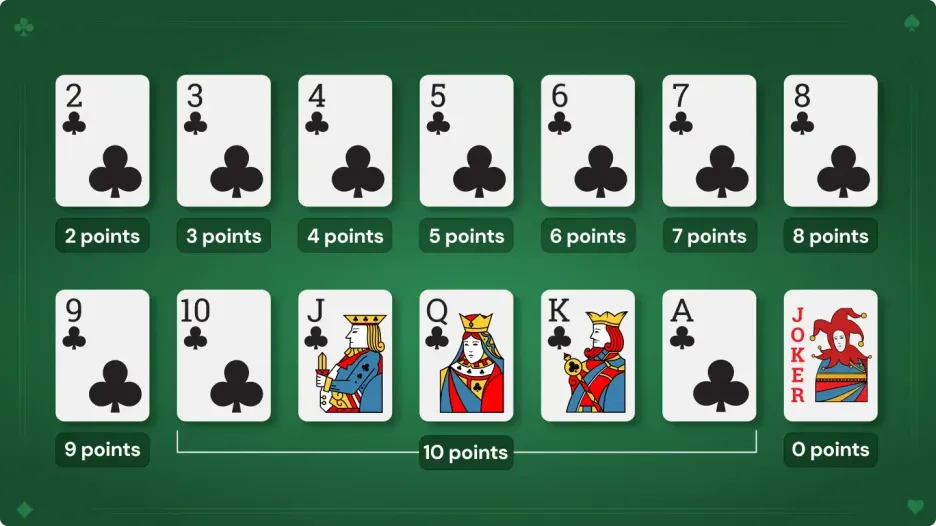
Value of each card in Indian rummy
Ranks of cards (from lowest to highest):
2 3 4 5 6 7 8 9 10 J Q K A*
Card Values
- Numbered Cards (2 to 10): Same as their face value
- Joker Cards (both printed and wild card): 0 points
- Face Cards: 10 points
- Ace Cards: 10 points*
*It is important to note that an ace card can be both the highest and the lowest ranking card depending on its usage, but its point value is always 10.
For instance, in the case of A♠️ 2♠️ 3♠️, the ace is the lowest-ranking card, while in Q♠️ K♠️ A♠️ it is the highest-ranking card.
Rummy Rules for making a valid declaration in rummy
Here is a handy chart to understand different kinds of melds in a 13-card rummy game:
| Characteristic | Pure Sequence | Impure Sequence | Sets |
|---|---|---|---|
| Definition | Consecutive cards of the same suit | Consecutive cards of the same suit but with a Joker card substituting a missing card | Cards of the same rank from different suits |
| Is it compulsory? | Compulsory to make a valid declaration | Not compulsory Can be formed to fulfill the requirement of forming 2 sequences | Not compulsory Can be formed to make a valid declaration |
| No. of cards needed | Formed with 3 or more cards | Formed with 3 or more cards | Formed with 3 or more cards |
| Usage of Joker cards | Can’t use printed Joker. Wild card Joker can be used only if it fits in pure sequence. | Can use both printed Joker or wild card Joker | Can use both printed Joker or wild card Joker |
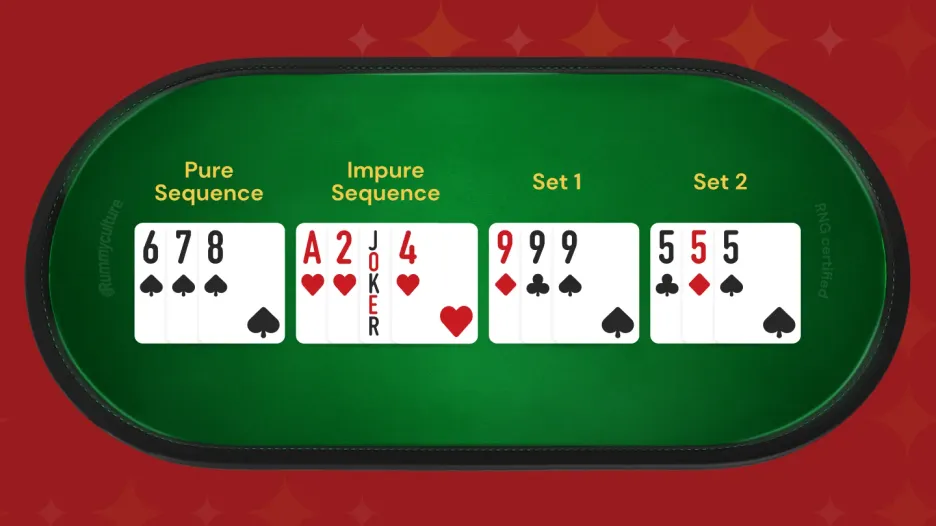
An example of a valid declaration in 13-card rummy
How game points are calculated as per rummy rules
Game points are calculated for the ungrouped cards in a hand. The winner of a game gets 0 points, because all their cards are grouped. For calculating the points, it is important to know the value of each card.
Consider this case of a 2-player game where wild card Joker is A♦️
| Player | Melds Formed | Calculation of Points |
|---|---|---|
| A |
A♠ 2♠️ 3♠️ 4♣️ A♦ 6♣️ 5♣️ 5♠️ 5♥️ 9♣️ 9♠️ 9♥️ 2♦️ |
This player has 1 pure sequence, 1 impure sequence, and 2 sets in the form of triplets. There is only one ungrouped card, i.e. 2♦️. Points for Player A: 2 |
| B |
10♦️ J♦️ Q♦️ 5♠️ 6♠️ A♦ 8♠️ 3♣️ 3♠️ 3♥️ J♠️ Q♠️ K♠️ |
This player wins because they have grouped all cards into valid melds and no ungrouped card remains. This hand has 1 pure sequence, 1 impure sequence (formed with the wild card Joker), 1 set of 3s, and another pure sequence of face cards. Points for Player B: 0 |
There are scenarios such as dropping or making an invalid declaration for which points are calculated differently. The maximum number of points a player can get in a single round is 80. Even if a player’s ungrouped cards add up to more than 80, they will still only be penalised 80 points.
There are other scenarios for which penalty points are predefined:
- First Drop: When a player drops on their first turn in a round before picking a card.
- Mid Drop: When a player drops on any other turn in a round except the first before picking a card.
- Consecutive Misses: When a player doesn’t play for a certain number of turns, it is considered and given the same points as a mid drop. The number of missed turns for dropping can be changed in the settings on the RummyCulture app.
- Invalid Declaration: An invalid declaration is considered a full drop and is usually penalised with the maximum points i.e. 80 points (except in 61 Pool).
Here is a guide to penalty points in different rummy formats if you drop from the deal:
| Game Format | On First Drop | On Mid Drop | Invalid Declaration |
|---|---|---|---|
| Points | 20 | 40 | 80 |
| Deals | 25 | 50 | 80 |
| 61 Pool | 15 | 30 | 60 |
| 101 Pool | 20 | 40 | 80 |
| 201 Pool | 25 | 50 | 80 |
In case a player has rightly grouped all their cards but fails to make a valid declaration first, they will be penalised with 2 points.
Winning amount calculation as per rummy rules
Every variant of rummy has a different system for the calculation of the winning amount. Understanding the calculations of each variant of rummy can help players perform better and win more in the game. Here’s a simplified version of each calculation.
For points rummy:
The winnings in a Points rummy game are based on a pre-decided point value. At the end of the game, the winner gets the monetary equivalent of the points of the other players.
Now, let’s see how scores and winnings are calculated at the end of a game. We will assume it is a standard Points rummy game with 6 players. Point value = ₹10. The Q ♣ is the wild card Joker.
| Player | Final Hand | Points |
|---|---|---|
| A |
3♣️ 4♣️ 5♣️ 6♣️ A♠️ 3♠️ 🃏 7❤️ 7♦️ 7♠️ 5♣️ 4♣️ 6❤️ |
15 Sum total of ungrouped cards: 5 + 4 + 6 |
| B |
4♣️ 5♣️ 9♣️ K♠️ 6♠️ 4♠️ 2♦️ 3♦️ 4♦️ 8❤️ 8♦️ 8♠️ 8♣️ |
70 Sum total of ungrouped cards: 4 + 5 + 9 + K (10) + 6 + 4 + 8 + 8 + 8 + 8 Even though there is a pure sequence, the lack of a second sequence makes the other groups invalid. |
| C |
K♠️ Q♠ J♠️ 10♠️ 9♠️ 8♠️ 4♦️ 4♠️ 4❤️ A♦️ 5♣️ 6♣️ 10❤️ |
43 Sum total of ungrouped cards: 4 + 4 + 4 + A (10) + 5 + 6 + 10 The 6-card pure sequence will be considered just 1 pure sequence. The player could have saved 12 points by splitting this pure sequence into two groups. On forming 2 sequences, 4♦️ 4♠️ 4❤️ would have been considered a valid set of 4s, saving the player 12 points. |
| D |
2❤️ 5❤️ 7❤️ 5♠️ 🃏 3♠️ A♣️ 9♣️ 9♣️ 10♦️ 3♦️ A♦️ Q♦ |
73 There are no pure sequences, so all cards will be considered ungrouped.The wild card Joker (Q♦ in this case) is always equal to 0 points. |
| E | <Dropped on the third turn - Mid drop> | 40 |
| F |
3♦️ 4♦️ 5♦️ 7❤️ 7♦️ 7♠️ 7♣️ A♠️ Q♥ 3♠️ 4♣️ 5♣️ 6♣️ |
0 Valid declaration- Winner |
The total points of the losing players (A, B, C, D, E) = 15 + 70 + 43 + 73 + 40 = 241
The winner will thus get: 241 × ₹10 = ₹2410 - (Platform fee)
The losing players will be paying as per the amount of points they had:
Player A would pay: 15 × ₹10 = ₹150
Player B would pay: 70 × ₹10 = ₹700
Player C would pay: 43 × ₹10 = ₹430
Player D would pay: 73 × ₹10 = ₹730
Player E would pay: 40 × ₹10 = ₹400
For pool rummy:
The prize pool for Pool rummy is predetermined and does not depend on the losing players’ points. There is a fixed Buy-In to participate in the game, and the prize pool is formed accordingly. There can be multiple rounds in a Pool game.
Let’s understand how scoring works for a 101 Pool (Buy-In of ₹10) with this example game:
| Player | Round 1 | Round 2 | Round 3 | Round 4 | Round 5 | ||||
|---|---|---|---|---|---|---|---|---|---|
| Points in R2 | Total Points | Points in R3 | Total Points | Points in R4 | Total Points | Points in R5 | Total Points | ||
| A | 17 | 0 (W) | 17 | 33 | 50 | 40 (MD) | 90 | 14 | 104 (E) |
| B | 26 | 13 | 39 | 42 | 81 | 0 (W) | 81 | 32 | 113 (E) |
| C | 4 | 14 | 18 | 0 (W) | 18 | 14 | 32 | 0 (W) | 32 |
| D | 0 (W) | 20 (FD) | 20 | 13 | 33 | 72 | 105 (E) | - | - |
| E | 34 | 40 (MD) | 74 | 30 | 104 (E) | 82 (R)* + 13 | 95 | 15 | 110 (E) |
| F | 80 (ID) | 7 | 87 | 20 | 107 (E) | - | - | - | - |
*Player E chose to rejoin, so their points will be equal to 1 point more than that of the player with the most points on the table. In this case, the highest individual points were 81 for Player A, so Player E rejoined at 82.
Legend:
W: Winner
ID: Invalid Declaration
MD: Mid Drop
FD: First Drop
E: Eliminated
R: Rejoin
With the least number of points, Player C is the winner of this 101 Pool game.
Prize: (No. of players) × (Buy-In) - (Platform fee)
Player C will get: 6 × ₹10 = ₹60 - (Platform fee)
For deals rummy:
Similar to Pool rummy, Deals rummy also has a pre-decided Buy-In amount. The winnings do not depend on the number of points of the losing players.
Let us see what the scoring would look like with an example:
For this example, we have considered a 6 players-3 deals game, where each player would start with 3 × 80 = 240 points per player.
At the end of Deal 1, this is the score-
Player A: 0 points (winner)
Player B: 62 points
Player C: 49 points
Player D: 32 points
Player E: 10 points
Player F: 36 points
Player A (the winner) will have (62 + 49 + 32 + 10 + 36) points added to theirs.
So Player A’s score would become 240 + 189 = 429 points
The other players will have those points deducted from their total. So, their points will now be:
Player B: 240 - 62 = 178 points
Player C: 240 - 49 = 191 points
Player D: 240 - 32 = 208 points
Player E: 240 - 10 = 230 points
Player F: 240 - 36 = 204 points
Similar calculations will happen at the end of Deal 2 and Deal 3 as well, and the player with the most points at the end of Deal 3 will be declared the winner.
See the following example to understand the scoring better.
| Player | Deal 1 | Deal 2 | Deal 3 | |||
|---|---|---|---|---|---|---|
| Points in D1 | Total Points | Points in D2 | Total Points | Points in D3 | Total Points | |
| A | 0 (W) | 429 | 19 | 410 | 27 | 383 |
| B | 62 | 178 | 15 | 163 | 0 (W) | 322 |
| C | 49 | 191 | 40 (MD) | 151 | 51 | 100 |
| D | 32 | 208 | 20 (FD) | 188 | 28 | 160 |
| E | 10 | 230 | 0 (W) | 328 | 33 | 295 |
| F | 36 | 204 | 4 | 200 | 20 | 180 |
Legend:
W: Deal Winner
MD: Mid Drop
FD: First Drop
Player A has the highest points and will thus be the winner of this Deals game.
Pro tips to win the rummy card game
Experienced players use various rummy tips and tricks that give them an edge over their opponents. Some of these are listed below:
Focus on forming a pure sequence first
To make a valid declaration, the first and foremost requirement is forming a pure sequence. Players should form a pure sequence with the cards dealt at the beginning of the game. It’s always advisable to drop out if you don’t spot a pure sequence after sorting your cards.
Discard high-value cards to reduce your final points
If high-value cards in your hand can’t be used to form a sequence or a set, discard them as soon as possible. By doing so, if an opponent declares before you, you will not lose by a high margin.
Use joker cards and ace cards smartly
Getting Joker cards in rummy has a significant advantage. You can use your Joker cards wisely to form sets or sequences with high-value cards. Also, ace cards can be used smartly to make sequences of lower values (such as A ♠️2 ♠️3 ♠️).
These are just a few and there are many more rummy tips and tricks which can be learned when you start playing regularly. The game of rummy demands skills and thorough practice is needed if you were to participate in real cash rummy tournaments being played by professionals.
For beginners, it is always recommended to learn it on free rummy games.
Rummy video tutorials
Mastering rummy is rather simple. Practice makes perfect, after all. Here are some rummy video tutorials to help you get started.
FAQs on rummy game rules
Have any doubts or need a quick refresher? These FAQs will provide bite-sized answers to all your questions related to rummy rules.
1. What are the rules of the rummy game?
The general rummy rules are: create a pure sequence first, then a second sequence, and then the rest of the cards can be grouped into sequences or sets. The objective of rummy is to be the first one to make a valid declaration.
2. How many cards are dealt in a game of rummy?
According to rummy rules, each player is dealt 13 cards in a game of rummy.
3. Are two Joker cards allowed in a single set in rummy?
Yes, you can make a set with 2 or even 3 Joker cards in rummy.
4. How do you form a pure sequence in rummy?
A pure sequence in rummy is formed with 3 or more consecutive cards from the same suit. A Joker card CANNOT be used in a pure sequence, unless it is a wild card Joker that fits into a pure sequence. For example: If Q ♥️ is a wild card Joker, and you have A ♥️ and K ♥️ of hearts, then you can use the wild card Joker to form a pure sequence (A ♥️K ♥️Q ♥).
5. What are the rummy game rules for making a valid sequence?
For a valid sequence, 3 or more cards need to be from the same suit and they should be consecutive. In case of a missing card, a Joker card can be used to complete the sequence.
6. What is an invalid sequence in rummy?
When the cards are not consecutive in a sequence, it is considered invalid. For example: 3♦ 4♦ 6♦ is an invalid sequence because it is missing a 5♦. This sequence can become valid if there is a Joker card with it, which will make it an impure sequence.
7. What are the consequences of an invalid/incorrect declaration by a player?
In case of an invalid/incorrect declaration by a player, they are penalised with 80 points (or 60 in case of 61 Pool format) and are dropped off from the deal.
8. Can a Joker be utilized in any sequence or set?
In general, Joker cards can be used in both sequences and sets, but not in a pure sequence. One exception is a wild card Joker that is from the same suit as the pure sequence and can fit with it.
9. How are the cards dealt in a game of rummy?
In a rummy game, 1 or 2 standard decks of cards are used for 2-6 players. Firstly, each player is dealt one card for the toss. The player with the highest-ranking card gets to go first. After the toss, each player is dealt 13 cards. RummyCulture is RNG-certified (Random Number Generator). RNG ensures that all cards are generated in an unregularised way. This way, all players are ensured complete fairness.
10. Is it allowed for a player to skip their turn in rummy?
Yes, a player may skip drawing a card on their turn. But this will lead to the player dropping out of the game after a set number of missed turns which will be considered a mid drop and penalised accordingly.
Related articles

Submit your review
Loved playing rummy on RummyCulture? Share your valuable feedback.
